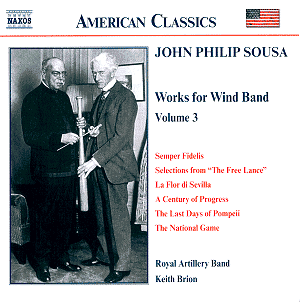The third in this Naxos
series, again by the Royal Artillery Band, England, with some marches
so popular that they might have appeared in the first introductory volume.
One should be aware that an American 'wind' band is commonly known in
Europe as a military band, containing both woodwind and brass instruments.
John Sousa was immensely
proud of his country, the United States of America, and in serving in
the forces accrued a personal power through the stirring military music
he wrote. By the age of 26 he had become conductor of the U.S. Marine
Band. The Band provided the facility to tour widely with a presence
at military functions. After a five-year gestation he commenced composing
for the band. Within twelve years he had become known as the 'March
King' and his heavy-beat march formula captivated American hearts.
Sousa marches are uncomplicated
pieces. Their rhythm and regular use of cymbals and bass drum are distinctly
Sousa. It would be unfair to suggest that he was incapable of composing
in other genres. Occasionally we come across a piece of music which
is not so mechanically inspired, contains more varied texture and is
much more languid in composition. The Last Days of Pompeii
is one such piece on this disc [tks.8-10], where inspiration came from
a then popular novel (same name) by Edward Bulwer-Lytton.
The first two numbers,
if not known by name, will be very familiar to the listener. These are
two of his most popular marches: Corcoran Cadets (composed
for a Washington teenage drill team) and Semper Fidelis
(a title taken from the U.S. Marine Corps' motto 'Always Faithful').
With a well-trodden formula used over a twenty-year period, Sousa did
not often stray into an unfamiliar style.
One of the best and most
interesting sequences is the selection from The Free Lance
[tk.3] - one of his operetta; yes, Sousa wrote operettas.
One will be aware of the
influence of the Austrian 19th Century masters in the El
Capitan waltzes: this is not surprising since Sousa had a liking
for their style. El Capitan was another of his operettas and
a very successful one on Broadway.
Both volumes 2 and 3 are
rather short in timing and it might have been more sensible for Naxos
to pool their resources and provide instead of three, two well-filled
discs.
The notes provided are
somewhat sketchy and it would have interested readers to be given details
of Sousa’s childhood, background and musical training. Useful and adequate
background material (in English) on each piece is included. The Royal
Artillery Band rise to the pomp and ceremony indicated by this military
music under the able conductorship of Keith Brion.
Raymond Walker
